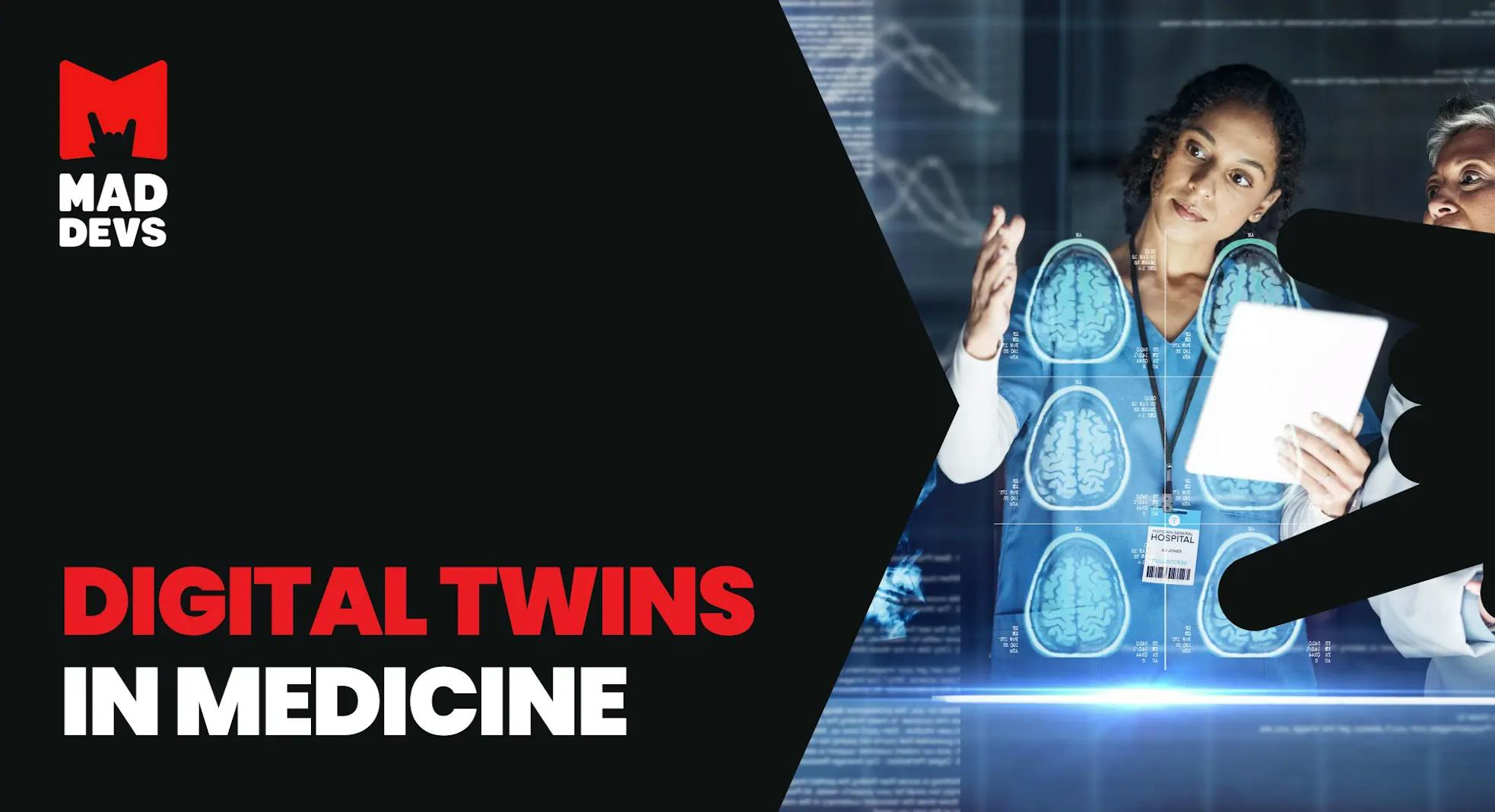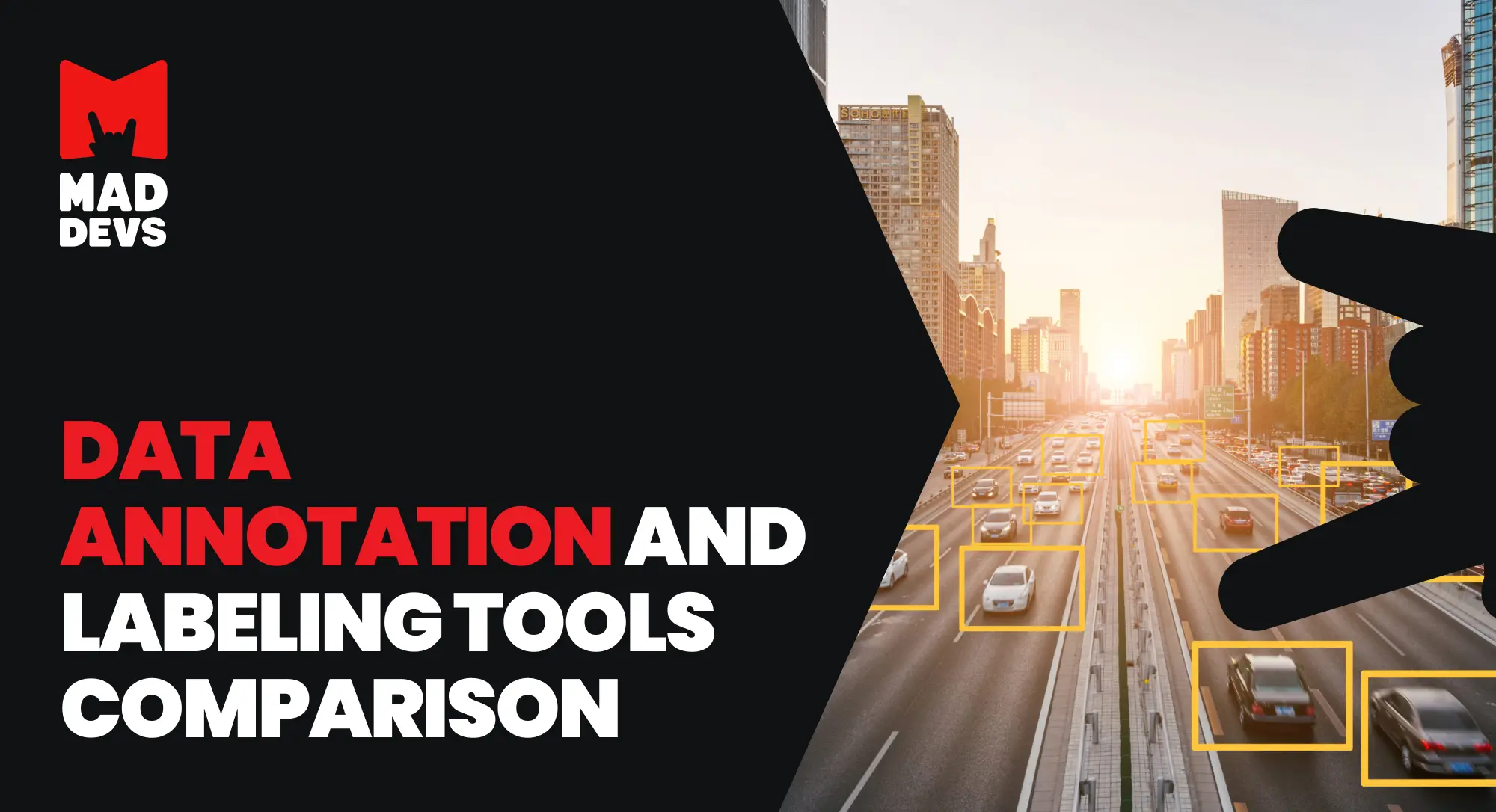The Industrial Revolution 4.0 is growing in momentum with the rise of faster wireless technologies for data exchange, more data collection, and the development of advanced approaches to data processing. Thus, today we can get an incomparably greater quantity and higher quality of data about the world than ever before.
This opens up fundamentally new possibilities and allows us to create new technologies that revolutionize how we approach the design, development, and application of new things in various fields, from manufacturing and transportation to medicine.
These technologies include digital twins, which we will talk about today. In this article, you will learn:
- What is a digital twin?
- How are digital twins work?
- What are the digital twin's opportunities and limitations?
- Which applications of digital twins are in different areas?
- How are digital twins transforming medicine?
- Which opportunities and limitations do they have in medicine?
- What is the market state of digital twins?
- What current applications do they have in medicine?
- And what future applications can we expect?
What are digital twins?
A digital twin is a virtual model of a real object, system, or process based on a variety of data collected from it by multiple connected sensors. We thus get a virtual model with all the real object's properties, characteristics, and states. And we can simulate various aspects of its operation with much less time, money, and energy.
This approach is popular for a variety of reasons. From calculating the best usage patterns, resource allocation, and other important aspects for areas such as the transportation industry, etc. To pre-calculating critical aspects of operations, design flaws, and more in areas where the cost of error is unacceptably high such as aviation, medicine, and others.

How do digital twins work?
Creating and using a digital twin requires several elements and occurs in several stages of their interaction.
Everything starts from a real object or system, which will be represented in the form of a digital twin. Physical objects include machines, buildings, production lines, vehicles, and cities.
Sensors are installed on the physical object to collect various data types such as temperature, pressure, humidity, speed, position, and more.
Connections provide periodic or continuous data exchange between objects and transfer them to a service using a variety of wired and wireless data exchange protocols.
Data can be structured as numeric values, tables, or unstructured as images, video, and text, and require analysis, cleaning, and aggregation to ensure accuracy and relevance.
Upon receiving the data, the service analyzes, cleanses, and aggregates it to create and update a virtual model that is a digital twin of the physical object.
A virtual model created by the digital twins software reflects the physical object's structure, functionality, and dynamics, enabling monitoring, analysis, and control of the object based on the received data and behavior modeling.
Possibilities of digital twins
Digital twins offer many different possibilities depending on the way and the area in which they are used. Let's look at the main ones, which are common in most cases.
- Modeling and simulation. They allow you to create virtual models of physical objects that can be used to conduct experiments and analyze various scenarios. This helps identify potential problems, evaluate alternative solutions, and test hypotheses without risking damage to real objects or endangering human life.
- Monitoring and analysis. They provide the ability to monitor the condition and performance of physical objects continuously. Analysis of collected data can help identify faults, equipment wear and tear, and resource efficiency, facilitating the timely detection and correction of problems.
- Management and optimization. They can optimize workflows, resource management, and equipment maintenance. This reduces costs, increases productivity, and improves overall system efficiency.
- Forecasting and planning. They enable the analysis of historical data and create predictive models for the future state and behavior of facilities. This facilitates decision-making and planning based on predictions, which helps determine the best strategies and resources to achieve goals.
Limitations of digital twins
Also, digital twins have some common limitations caused mainly by a lack of quantity or quality of data. Let's take a look at the main causes and consequences of this.
- Complexity and cost. Designing and implementing digital twins can be a technically complex and expensive process, including the cost of hardware, software, and expertise for system design and support.
- Quality data needs. Digital twins require large amounts of quality data to create a complete model of an object or system. A limited or poor-quality data set can lead to an incomplete unusable model.
- Need for accuracy. Digital twins must be accurate to ensure effective use. Inaccuracies in modeling can lead to erroneous decisions and actions that can negatively affect real-world objects or systems.
- Complexity of integration. Digital twins often require integration with existing control and monitoring systems. This process can be technically complex, time-consuming, and require additional material or human resources.
- Limited scope of application. Digital twins can only be applied in areas where objects or systems exist that can be modeled and simulated. In some cases, digital twins may be less useful or not applicable due to specific features of objects or systems.
Digital twins applications in different industries
While the primary purpose of this article is to show the use of digital twins in medicine, we cannot avoid examples from other industries since their use in many of them has already ceased to be an unaffordable innovation and has become the standard for efficient and reliable operation. Let's look at which industries we are talking about and how exactly digital twins are used there.
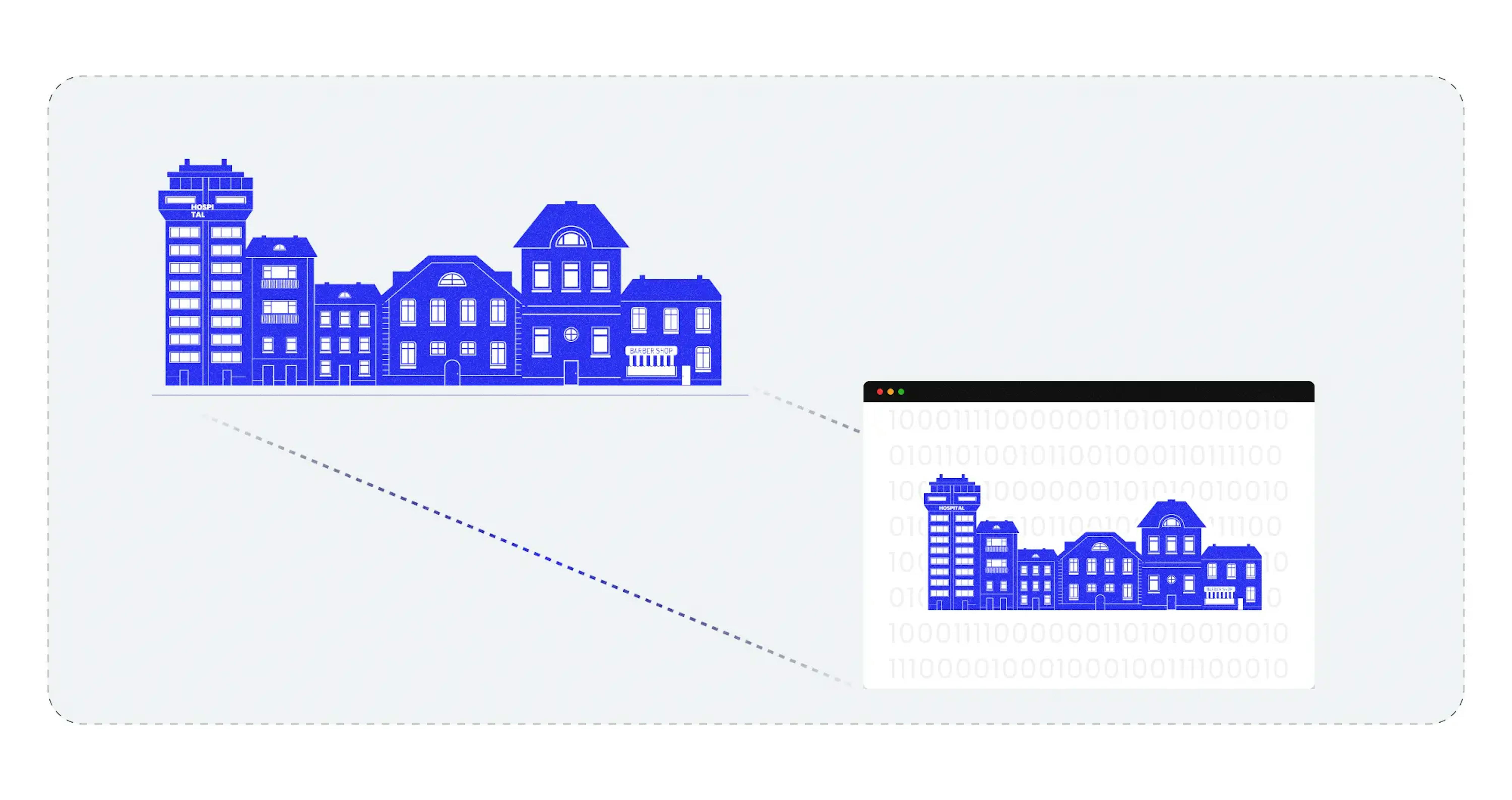
Manufacturing
- Process optimization. Digital twins help identify bottlenecks and opportunities to improve production processes like cost savings, waste reduction, and shorter production times.
- Predictive maintenance. They predict equipment wear and tear based on sensor data, enabling timely care and avoiding unforeseen downtime.
- Quality control. Digital twins help to monitor and analyze product quality and take corrective action when problems are detected.
Construction
- Join projects. Digital twins make coordinating between different project teams easy, preventing errors and delays.
- Resource management. They provide transparency and control over materials, equipment, and labor to streamline construction.
- Using Building Information Modeling (BIM). They enable the integration of BIM models to improve building planning, design, and operations.
Mining
- Reservoir modeling. Digital twins allow the creation of accurate reservoir models, given geological, geophysical, and engineering data.
- Production optimization. They help determine optimal extraction methods and techniques, accounting for economic and environmental factors.
- Monitoring and control. They continuously monitor equipment and infrastructure to enable timely maintenance and prevent accidents.
Energy
- Optimization for energy generation and distribution. Digital twins help model and optimize energy systems based on weather, demand, and availability.
- Asset management. They can monitor the condition of equipment and infrastructure, enable timely maintenance, identify resources that need to be replaced, and prevent accidents.
- Renewable energy integration. They enable better planning and integration of renewable energy sources, such as solar panels and wind turbines, and optimize their performance in the energy system.
Aircraft, marine, and automotive industry
- Prototyping and testing. Digital twins enable virtual prototyping and testing, reducing the time and cost of developing new products.
- Design optimization. They can determine the most efficient and lightest designs, reducing weight and increasing vehicle efficiency.
- Monitoring and diagnostics. They provide remote vehicle condition monitoring and diagnostics to help prevent accidents and minimize downtime.
All key industries are interested in digital twins in one way or another because they take their operations to the next level. This is true not only for these industries but also for any other, from as large as supply chains and trucking to e-commerce and local retail. If you also want to increase the transparency and efficiency of your business fundamentally, you can contact us for a free consultation. Using our rich expertise, we will individually review it and offer the most rewarding solution for you.
Now let's move on to an industry where digital twins have one of the greatest potentials, and their increasing spread and deep adoption already produce many amazing results.
Digital twins in medicine
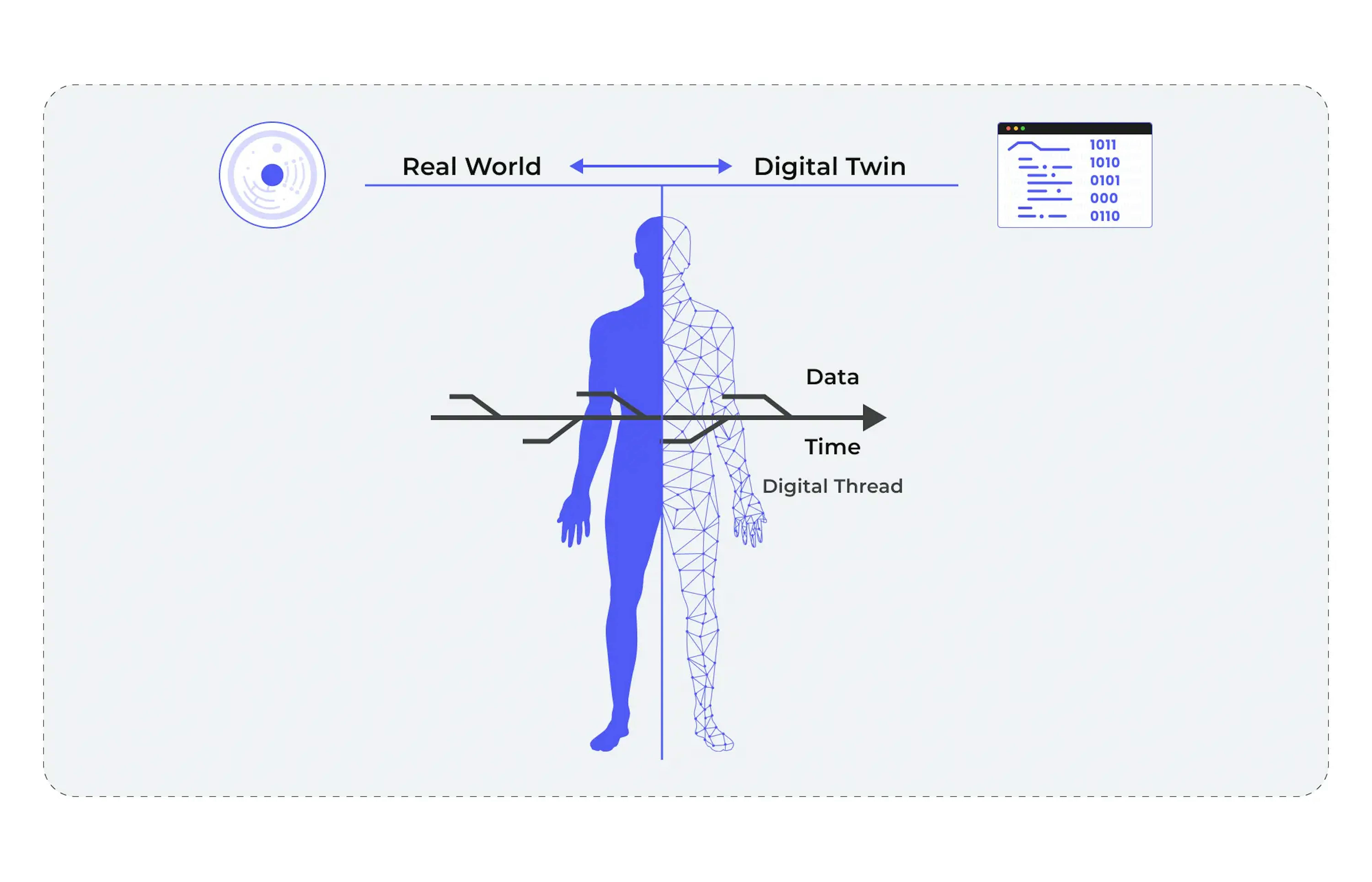
In medicine, digital twins work by integrating and analyzing data from various sources, such as diagnostic tests, medical records, and patient monitoring. First, sensors and diagnostic equipment collect information about the patients, organs, or biological systems. Data is transferred to services, where it is processed and analyzed.
A virtual model of the patient, a specific organ, individual tissues, or even molecules is built from the collected data using specialized algorithms and machine learning. This model simulates various scenarios and interventions, allowing medical professionals to assess their potential outcomes and risks.
During the course of treatment and patient monitoring, the digital twin is continually updated with new data to ensure that the model is up-to-date and accurate. Medical professionals can use this data to adapt and adjust treatment, evaluate the techniques' effectiveness, and develop optimal treatment and rehabilitation strategies.
In this way, digital twins in medicine function as dynamic virtual models that allow physicians to simulate different treatment scenarios, evaluate their results, and determine the most appropriate strategies for each individual patient.
Possibilities of digital twins in medicine
- Individualization of treatment. Digital twins allow the development of personalized treatment plans that take into account the unique characteristics of each patient's body, increasing the effectiveness of treatment and reducing the risks of side effects.
- Optimizing surgical interventions. Its simulations help to plan and practice surgical procedures, reducing the chance of human error and accelerating the patient's recovery.
- Disease prediction. They can predict the disease's progression and course, considering more factors than a human can, allowing for early detection and prevention.
- Drug development. They help to model biological processes and molecular interactions, accelerating the selection of effective and safe drug candidates.
- Virtual clinical trials. They enable virtual clinical trials of new drugs and treatments much faster and without risk to patient health.
- Educate and train medical personnel. They can be used to train physicians and medical students, allowing them to gain a nearer-to-real-world experience more quickly.
Limitations of digital twins in medicine
- Complexity and cost. Creating and maintaining digital twins can be a complex and costly process, especially when dealing with large amounts of data and high levels of detail.
- Data needs. It requires large amounts of quality and up-to-date data to create and maintain virtual models, which can be difficult to accomplish with limited access to information or insufficient infrastructure for data collection.
- Accuracy of models. They must be accurate enough to ensure effective use in medicine. Errors in modeling can lead to incorrect diagnoses and incorrect treatments.
- Integration challenges. It may require integration with other more classic systems and technologies, which can be a complex process and require additional resources.
- Security and privacy concerns. Data security and patient privacy issues are also significant constraints, as the collection and storage of medical data must meet strict standards and regulatory requirements.
Digital twins current applications in medicine
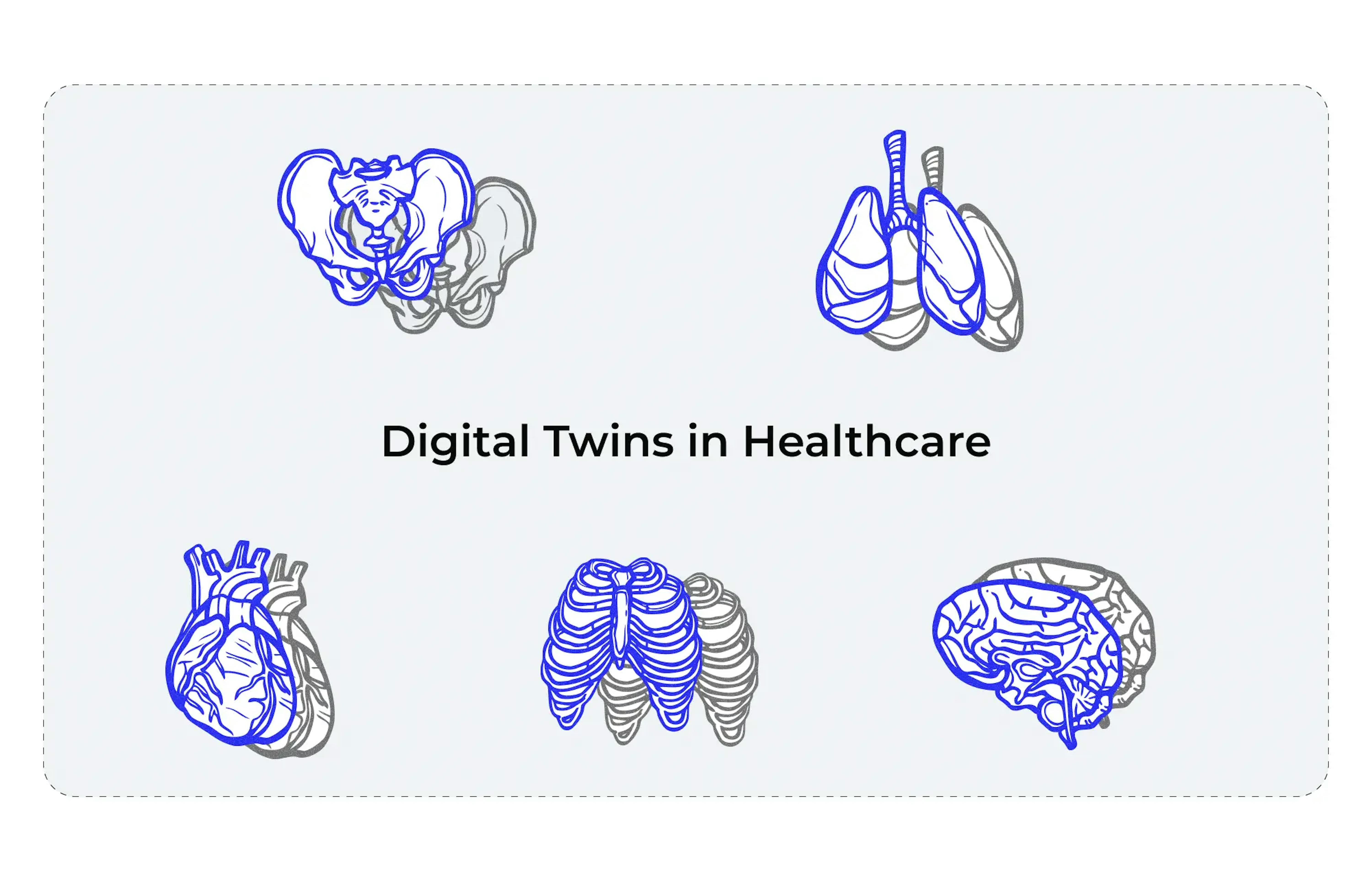
Dassault Systèmes and the Living Heart Project
Dassault Systèmes has created a 3D digital heart twin that enables physicians and researchers to understand the heart better and develop more accurate ways to diagnose and treat cardiovascular disease. This Living Heart Project is an interdisciplinary initiative that brings together leading cardiovascular medicine, bioengineering, and computer modeling experts.
Siemens Healthineers and Corindus Vascular Robotics
Siemens Healthineers has acquired Corindus Vascular Robotics, which has developed robotic systems for vascular interventions. One area of focus is the creation of digital vascular duplicates that allow specialists to simulate and optimize procedures before they are performed on patients.
Insilico Medicine
Insilico Medicine uses artificial intelligence and digital twins to accelerate the development of new drugs. The company models biological systems and processes at the molecular level, allowing it to identify the most promising drug candidates and reduce the risk of side effects.
Boston Scientific and the RHYTHMIA Mapping System
Boston Scientific has developed the RHYTHMIA Mapping System for creating three-dimensional maps of the heart's electrical activity that are used as digital twins for planning and performing catheter ablation in treating arrhythmias. The system allows physicians to quickly and accurately identify the sources of arrhythmias and develop the most effective treatment strategy with minimal risk to the patient.
HeartFlow and HeartFlow Analysis
HeartFlow uses computer modeling and artificial intelligence to create detailed three-dimensional models of patients' coronary arteries. HeartFlow Analysis is a noninvasive diagnostic procedure that determines the extent of arterial stenosis and calculates fractional blood flow reserve. This data helps physicians determine the most appropriate treatment plan for each individual patient.
Materialise Mimics and 3D printing
Materialise Mimics provides digital twins software for processing medical images and creating 3D digital models of anatomical structures. These models can be used as digital twins for surgical planning, medical training, and 3D printing of customized implants and surgical instruments.
IBM Watson Health and Oncology
IBM Watson Health has developed an artificial intelligence platform for oncology that uses digital twins of patients to determine the most appropriate cancer treatments. The system analyzes patients' medical data, including genetic markers and information about their diseases, to provide individualized treatment recommendations based on scientific research and the practical experience of specialists.
Digital twins future applications in medicine
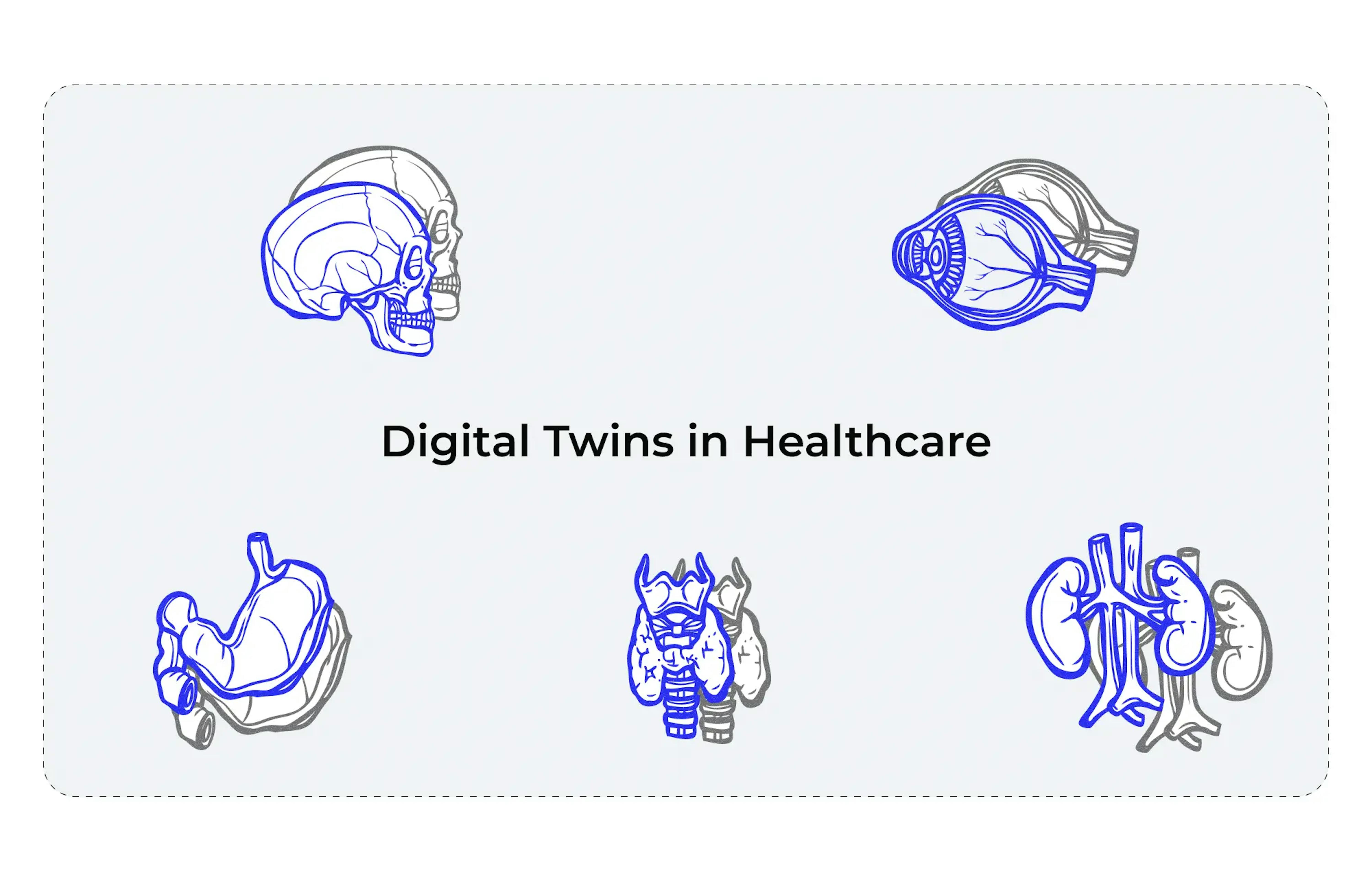
Digital twins for telerobotic surgery
Intuitive Surgical, the famous da Vinci robotic surgery system developer, is researching the use of digital twins to improve surgical precision and safety. Their research focuses on tracking the position and movement of instruments by comparing them to a pre-designed model of the surgical procedure. This allows for more accurate surgical procedure planning, monitoring, and evaluation.
Digital twins for transplantation
The Wyss Institute and Harvard Medical School are developing advanced methods to analyze and predict cell and tissue behavior when creating functional 3D organ models. This will enable a better assessment of donor-recipient compatibility at the cellular level, taking into account molecular mechanisms of rejection, which helps to reduce the likelihood of complications after transplantation.
Digital twins for regenerative medicine
The Salk Institute is researching many medical directions like computation biology, neurobiology, and more. But one of their research about regeneration is to create digital twins of tissues using genetic editing techniques and stem cells to model the regeneration of damaged tissues and organs. This includes analysis of genetic regulation, signaling cascades, and cell population dynamics to determine optimal conditions for stimulating regeneration.
Digital twins of the microbiome
The research group at Caltech is developing computer models of the microbiome using metagenomic data and machine learning to analyze and predict microbial community dynamics. This will clarify understanding of the role of the microbiome in disease development and is helping to develop individualized treatment strategies based on microbial therapies.
Digital twins of the immune system
The Cold Spring Harbor Laboratory project explores the creation of digital twins of the immune system, using genetic sequencing techniques and machine learning to analyze the dynamics of immune cells in response to various pathogens. This enables the identification of optimal treatment strategies for infectious diseases and immune disorders and improves the development of vaccines and immunotherapies.
Digital twin for neural networks
A research group at the University of Cambridge is creating digital brain twins to study Alzheimer's and Parkinson's disease. Using automated methods to analyze medical images and genetic data, scientists are identifying key biomarkers and pathological mechanisms, allowing them to develop new approaches to diagnosing and treating neurodegenerative diseases.
Digital twins for nanomedicine
Insilico Medicine is collaborating with the University of Hong Kong to develop molecular digital twins to study nanoparticle-cell interactions. Using machine learning and molecular modeling, researchers determine the optimal characteristics of nanoparticles for drug delivery and gene therapy, given the specificity of biological systems. This improves the efficiency and safety of nanomedicine and reduces the time and cost of developing new drug forms.
Digital twins market overview
The total market for digital twins is currently valued at $12.9 billion and is expected to grow at a CAGR of 36.3% to reach $154.0 billion by 2030, according to Globaldata.
The main distribution share now is the United States and Canada, which account for about 40%, and the European countries account for about 30% because of their data collection and processing infrastructure state. Also, the largest place in the digital twins market is shared by manufacturing, construction, and medicine, largely due to the widespread adoption and implementation of technologies such as IoT and AI.
The state of the digital twin market directly in healthcare is $462.6 million in 2021 and is expected to have a CAGR of 25.6% from 2022 to 2030, according to Grand View Research.
And although all research agencies are confident in the future growth of this market, the accuracy of these forecasts may vary, as building the digital twins remain expensive and not every company can afford them. In the figures they provide, the cost of creating a digital twin for a Grade A commercial building of about 60,000 square meters to be between $1.2 million and $1.7 million, and for complex and large facilities of 200,000 square meters, the cost rises to $3-4.2 million.
In collaboration with research institutes, well-known technology companies such as IBM, Microsoft, Amazon, and Siemens play key roles in this market. However, the market is much larger, with many other big companies doing cutting-edge development and providing advanced products, and even many successful startups receiving grants and investments. We have a great article about how to consider BioTech startups for investment and which ones are worth considering. We highly recommend checking it out.
Summary
Our world is increasingly moving into digital space. This applies to our communication, work, and entertainment and even to the migration of entire factories, biological systems, and molecular interactions. While many are afraid of this, it already allows us to significantly optimize entire industries, reduce waste, predict the progress of diseases, and find new cures and types of drugs tens or hundreds of times faster than before.
And digital twins are a proven and actively developing an approach that takes all of this and helps make our world and our lives much better. We at Mad Devs know what we're talking about because we already have experience in development with cutting-edge research companies and understand how important it is.
And if you still have questions or your company needs help with development, you can always sign up for a free consultation. We will listen to you carefully and review your project, offering the most profitable and effective solution.

